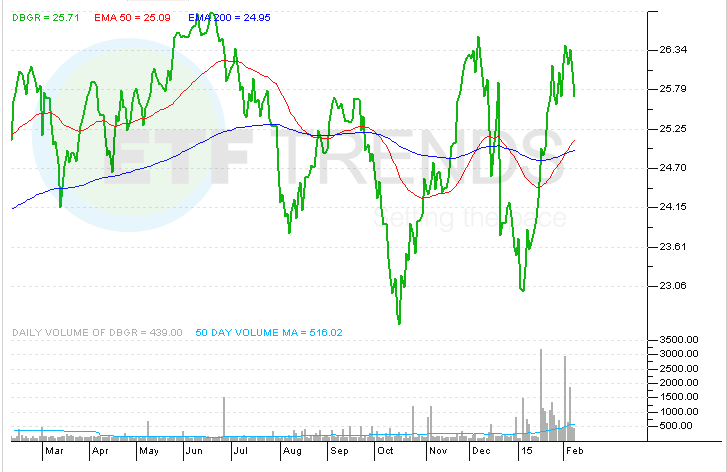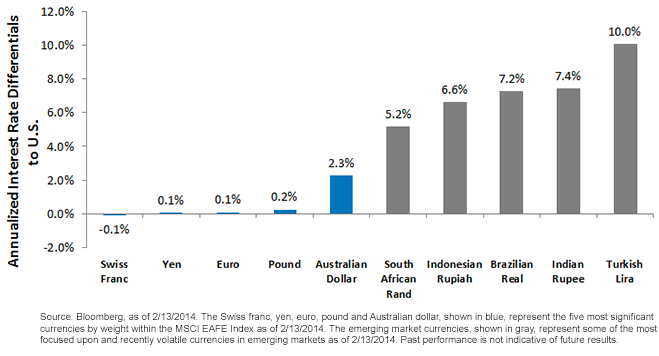Currency Hedged Equities The Plain Vanilla Approach
Post on: 6 Август, 2015 No Comment

Currency Hedged Equities – What’s Plain Vanilla?
by Jeremy Schwartz. Director of Research on February 27, 2014
The concept of hedging one’s currency exposure on international equity investments has been building momentum—especially in light of Abenomics taking hold in Japan during 2013. A primary question we see being discussed is whether a currency-hedged equity strategy belongs as part of a portfolio’s core international allocation or as a more satellite-oriented tactical approach.
Since unhedged strategies have been around longer, conventional thinking is that they are the default option and the “plain vanilla” approach to international investing. Today, WisdomTree offers a suite of equity exchange-traded funds (ETFs) which are unhedged covering international and developed markets. But, we also believe that currency hedging may make sense in certain equity markets. WisdomTree has a family of six currency-hedged equity ETFs.
I would argue that utilizing currency hedging to target the local equity returns could actually be the more “plain vanilla” approach. Let’s accept a common industry view that in many cases, currency exposures are a wash in the long run, meaning that they offer no expected return enhancement. If there is no expectation of positive return, what is the rationale for taking a secondary, ancillary currency bet that may substantially increase the risk profile of the portfolio?
Why is it that the vast majority of international funds are unhedged, offering exposure to both equity returns and currency returns? A Vanguard research paper in 2010 1 offered some of the conventional thinking, which we believe is worth referencing even today as the broader themes and ideas haven’t shifted much in the past four years:
“When we evaluated five major currencies, we found that, counterintuitively, currency hedging of a global equity portfolio provided only modest risk-reduction benefits. … Thus, if the costs of a currency-management program are nontrivial, any positive benefits will very likely be negated. Further, given the high volatility in the data, hedging of foreign-currency exposure did not produce any statistically significant value-added from a risk-adjusted-return standpoint.”
Vanguard makes a very important point about the costs of currency hedging, which we will further explore below. This is one of the most important points about the outlook for currency-hedged strategies over the coming years, and the currently trivial cost of hedging the euro or the yen makes these strategies attractive to us.
What Is Plain Vanilla?
Again, the central question, we believe, is why is the “plain vanilla” option to have both currency exposure and equity exposure combined in an unhedged format? The “plain vanilla,” I would argue—in the purest sense of the term “plain vanilla”—is pure local equity market return with no secondary “chocolate fudge” on top.
ETFs that provide both equity and currency returns should not necessarily be the definition of plain vanilla—and therefore the automatic default options for international equity exposure—just because they’re the oldest listed ETFs. One can argue that currency-hedged ETFs are more plain vanilla and a more natural starting point. Investors who have a positive outlook on the currency can start adding in the secondary currency exposure if they so desire.
The Trade-Offs of Hedging
In its research report, Vanguard made the point that it can be expensive to hedge foreign currencies and that this represents a high hurdle for how much a currency has to depreciate to overcome this high cost.
The truth today is that hedging foreign currencies is only expensive in some cases—particularly emerging markets such as India and Brazil—but can be inexpensive for Europe and Japan.
The Interest Rate Differentials : An important cost of currency-hedged strategies is embedded in the nature of how currency hedging works, which is the interest rate differential between the currency of the investor’s home market and the interest rate in the currency the investor is looking to hedge.
In markets that have much higher interest rates than the U.S.—e.g. Brazil or India—the cost to hedge the currency can be very high, currently as much as 7% per year. 2 The graph below, which shows the current interest rate differentials, illustrates the divide between certain developed and emerging markets.
The Divide between Developed and Emerging Markets
Three currencies—euro, yen and British pound—make up approximately three-quarters of the MSCI EAFE Index weight, and the cost to hedge each of them is less than .25%. 3 One might actually get paid something more meaningful to hedge the yen, given that interest rates in the U.S. may increase before those in Japan do, as can be the case if interest rates in an investor’s home country are higher than in the country of the currency being hedged (as is the situation of the Swiss franc; see above).
The bottom line of this cost discussion: currently, the costs are minimal in the developed world and high in some emerging markets. With a practically free option to hedge the risk in Japan and Europe, is it worth taking the risk again for no expected return enhancement in the long run if currency returns are a wash?
Vanguard also argued in its report that there is only a marginal benefit to volatility reduction for equities but that currency volatility can dominate fixed income returns, so that is where currency hedging pays, according to them. Recent facts suggests otherwise.
Over the last five years, the volatility to European equities with euro exposure 4. 26.2%
Over the last five years, the volatility to European equities 5. 18.1%
Volatility contribution of the euro: 8.1%
That is, the euro exposure increased the volatility to European investments for U.S. investors by 8 percentage points. In other words, fully 30% of all the volatility for European equities came from the euro. 6 The 30% contribution of total volatility is the same over the last decade (22.9% total volatility, including 6.1% currency volatility). 7 I would say that is a meaningful amount of volatility to come from currency risk.
The Case of Japan: Upside Volatility Desired There
Regarding whether hedging currency can increase volatility in certain markets—that certainly has been the case for Japan. In 2013, a declining yen offset appreciating equities and hurt investors from a total return perspective—but one can say those offsetting returns helped lower volatility. Is that the lower volatility investors wanted when accessing Japanese equities? The flows to currency-hedged Japan ETFs suggest investors thought the currency-hedged, local equity-targeting returns were more desirable.
Reframing the Question
The future direction of currencies is tough to predict. This is why I ask: Do you want a secondary currency exposure on top of your local equity returns? If there is little cost to hedge, as there is in Europe and Japan today, you may need significant faith in the euro and the yen if you are going to take that risk unhedged. How many people have such faith in the euro and the yen? My guess is a lot fewer than the number who implicitly take on the risk with traditional, unhedged ETFs.

As one commentator from the Society of Actuaries put it, for most, leaving currency risk unhedged is akin to betting money on coin flips. 8
1 Karin Peterson LaBarge, “Currency Management: Considerations for the Equity Hedging Decision,” Vanguard Research, September 2010.
2 Source: Bloomberg, as of 2/13/2014.
3 Source: Bloomberg, as of 2/13/2014.
4 European equities with euro exposure: Refers to the returns of the MSCI EMU Index, which is exposed to changes in the exchange rate between the euro and U.S. dollar. Five-year period from 12/31/2008 to 12/31/2013.
5 European equities: Refers to the returns of the MSCI EMU Local Currency Index, which is not exposed to changes in the exchange rate between the euro and U.S. dollar. Five-year period from 12/31/2008 to 12/31/2013.
6 Sources: MSCI, Zephyr StyleADVISOR, as of 12/31/2013.
7 Sources: MSCI, Zephyr StyleADVISOR, as of 12/31/2013.
8 Source: Steve Scoles, “Currency Risk: To Hedge or Not to Hedge—Is That the Question?,” Risks and Rewards newsletter, Society of Actuaries, February 2008.
Important Risks Related to this Article
There are risks associated with investing, including possible loss of principal. Foreign investing involves special risks, such as risk of loss from currency fluctuation or political or economic uncertainty. Investments focused in Japan and Europe are impacted by the events and developments associated with the region, which can adversely affect performance. Investments in emerging, offshore or frontier markets are generally less liquid and less efficient than investments in developed markets and are subject to additional risks, such as risks of adverse governmental regulation and intervention or political developments. Investments in currency involve additional special risks, such as credit risk and interest rate fluctuations. Derivative investments can be volatile, and these investments may be less liquid than other securities, and more sensitive to the effects of varied economic conditions.
Fixed income investments are subject to interest rate risk; their value will normally decline as interest rates rise. Fixed income investments are also subject to credit risk, the risk that the issuer of a bond will fail to pay interest and principal in a timely manner, or that negative perceptions of the issuer’s ability to make such payments will cause the price of that bond to decline. As certain funds can have a high concentration in some issuers, those funds can be adversely impacted by changes affecting those issuers. Due to the investment strategy of certain funds, they may make higher capital gain distributions than other ETFs. Please read the Fund’s prospectus for specific details regarding the Fund’s risk profile.
Investments in emerging, offshore or frontier markets are generally less liquid and less efficient than investments in developed markets and are subject to additional risks, such as risks of adverse governmental regulation and intervention or political developments.
ALPS Distributors, Inc. is not affiliated with Vanguard.














